Essential Tools You Need to Stop a Dripping Faucet Fast

A dripping faucet can be more than just an annoyance; it wastes water and can increase your utility bill. Fortunately, stopping a drip fast is possible with the right tools and know-how. This article will guide you through the essential tools you need to quickly fix that persistent drip and keep your faucet in good working order.
Identify the Type of Faucet
Before gathering your tools, it’s important to identify whether you have a compression faucet, cartridge faucet, ball faucet, or ceramic disc faucet. Each type may require different approaches or parts for repair. Knowing this helps you prepare appropriately and ensures you won’t waste time or money on incompatible tools or replacement parts.
Basic Tools Needed for Most Faucet Repairs
To tackle most dripping faucets swiftly, you’ll want to have an adjustable wrench handy to loosen nuts without damaging them. A flat-head and Phillips screwdriver are also essential for removing handles and accessing internal components. Additionally, having needle-nose pliers helps in handling small parts like washers or O-rings safely.
Replacement Parts Often Required
Dripping faucets often result from worn-out washers, O-rings, or valve seats. Having a basic faucet repair kit that includes these components can save time during repairs. These kits are generally affordable and compatible with various types of faucets.
Additional Helpful Items
A flashlight can help you see clearly under sinks where lighting might be poor. Plumber’s grease is useful to lubricate parts during reassembly for smooth operation and longer lifespan of seals and moving components.
Steps to Stop the Drip Quickly
Firstly, turn off the water supply valves beneath the sink to prevent leaks while working. Then disassemble the faucet handle with your screwdrivers using care not to strip screws. Inspect washers and O-rings; replace any damaged parts using pliers if needed. Apply plumber’s grease before reassembling everything tightly but avoid overtightening which might cause damage. Finally turn water back on slowly and check if dripping stops.
Having these essential tools at hand allows you to respond quickly when faced with a dripping faucet problem instead of waiting for professional help which could take time and cost more money. By understanding your faucet type and keeping basic repair supplies ready, fixing leaks fast becomes manageable even if you’re not a plumbing expert.
This text was generated using a large language model, and select text has been reviewed and moderated for purposes such as readability.


